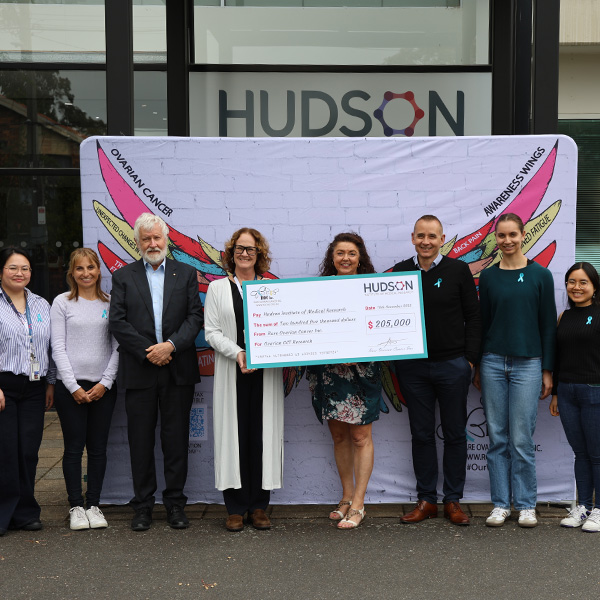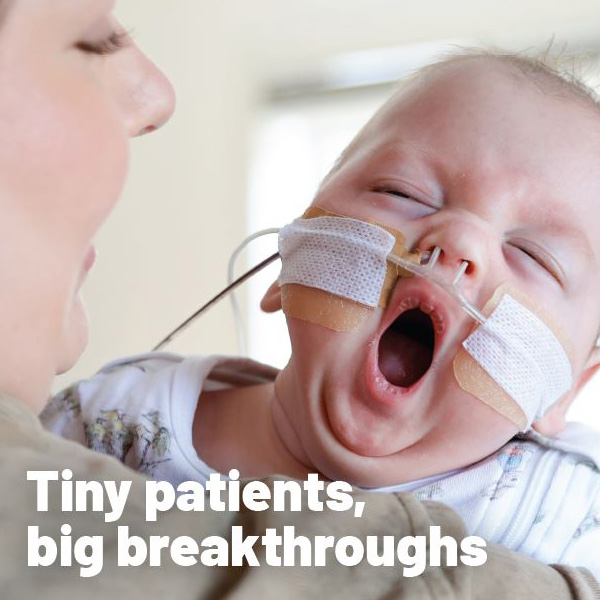World-first trial of placental cell treatment helping premature babies
By Hudson Institute communications
A world-first therapy, developed at Hudson Institute of Medical Research and Monash University, using cells from the human placenta to repair the damaged lungs of premature babies, is giving hope to families of the most fragile infants like Harry Campbell.

The results of a clinical trial at the Monash Children’s Hospital – the culmination of more than 10 years’ work for the team of clinicians and researchers – have been published today in the journal STEM CELLS Translational Medicine.
Six preterm babies with the chronic lung disease bronchopulmonary dysplasia (BPD) were given a single low dose of amniotic epithelial cells (hAECs) in the first-in-human safety trial.
BPD is the most common disease affecting premature babies. The smaller the baby, the greater the risk of them developing this chronic preterm lung disease and, if BPD takes hold, there is no cure and it can cause multiple life-long health impacts.
“This is the first step towards a therapy for very vulnerable premature infants who currently have no other effective treatment. BPD is a devastating disease, these babies often suffer severe and life-long conditions,” Dr Rebecca Lim, joint first author of the study, said.
“Our results show that this amnion cell therapy can be safely used in babies with lung disease. When we are able to tackle lung disease, the risk of developing many other life-long problems that go hand in hand with BPD, such as cerebral palsy, is also reduced,” she said.
‘Giving infants a fighting chance’
Harry Campbell was one of the first babies to receive the treatment in the safety trial. He was born very premature at 27 weeks gestation and developed BPD. Now 15 months old, Harry has started crawling and no longer requires oxygen support, his mother, Belinda Campbell, said.
“When Harry took part in the safety trial, we knew there was a small chance this could help him, and that’s great – but if this research could help another family in the future not to have to go through what we went through – if it helps other babies with BPD – then that is such a positive,” Belinda said.

“The results are excellent, showing that donor cells are well-tolerated and safe and that there were improvements in some of the babies,” said Harry’s treating neonatologist and joint lead researcher, Dr Atul Malhotra.
Victorian Minister for Health the Hon. Jill Hennessy said the world-first development is another example that Victoria is home to some of the best and brightest medical researchers.
“Developments like these have the power to change lives, save lives and give some of our most fragile infants a fighting chance,” said Ms Hennessy.
“Our world-leading researchers and medical experts are helping us learn more and more about crippling diseases, so that we can develop better treatments and give better care to those who need it most.”
About the treatment
Amnion epithelial cells were extracted from the amniotic sac, which surrounds the baby during pregnancy and is usually discarded with the placenta in the afterbirth. These cells were then administered intravenously to babies with BPD.
Previously, in pre-clinical studies, the team was able to show that amnion epithelial cells completely repaired damaged lungs. The cells work by attaching themselves to the damaged lungs and kick-start the lung’s own repair process.
“Amniotic cells gather at areas of damage and activate the body’s own ability to repair the injured lungs,” Dr Lim said.
Next steps
The study results have paved the way for a larger Phase II trial, to determine the optimum cell dosage and frequency. It will involve 24 extremely premature babies at risk of developing BPD from Monash Children’s Hospital and Royal Women’s Hospital.
“This would be a very practical treatment. If a baby was known to be at-risk, a vial of cells could be ready and given to the baby shortly after birth,” Dr Lim said.
“Our long-term aim is to develop a treatment for premature babies with chronic lung diseases like bronchopulmonary dysplasia, which could be rolled out in hospitals around the world,” Dr Malhotra said.
“If we can intervene in the days after their birth with these cells to successfully ‘rebuild’ these babies’ lungs, we could increase survival rates and halt long-term complications,” he said.
What is BPD in premature babies?
Bronchopulmonary dysplasia (BPD) is a form of chronic lung disease that affects up to 50-60 per cent of extremely premature babies.
BPD occurs when immature newborn or premature lungs are exposed to ventilation. While life-saving, this breathing support can also cause damage to tiny developing lungs. Once this damage is established, there is no cure for BPD.
Babies with BPD may suffer severe lifelong complications, including impaired neurodevelopment, and are highly susceptible to airway infections that may lead to death. The survivors of moderate-to-severe BPD often go on to develop chronic lung diseases in adolescence and early adulthood.
BPD statistics
- Bronchopulmonary dysplasia (BPD) is the most common disease affecting premature babies.
- The smaller the baby, the greater the risk and the greater the severity of the disease.
- Almost 1 in 10 babies in Australia are born premature and up to 60 per cent of extremely premature babies will develop BPD.
- BPD affects the alveoli, the tiny sacs in the lungs that enable the entry of oxygen into the bloodstream and the clearance of carbon dioxide from the body.
- There is currently no safe and effective treatment for BPD.
What are amnion epithelial cells?
An amniotic epithelial cell is a stem-like cell extracted from the lining of the inner membrane of the placenta. They have ability to grow into any cell in the body, in a similar way to stem cells. Each placenta produces about 150-200 million amnion cells.
Team | Rebecca Lim, Atul Malhotra, Jean Tean, Siow Teng Chan, Sinnee Lau, Dandan Zhu, Joanne Mockler, Euan Wallace.
Contact us
Hudson Institute communications
t: + 61 3 8572 2697
e: communications@hudson.org.au
For clinical trial enquiries, please contact
Dr Rebecca Lim
e: rebecca.lim@hudson.org.au
About Hudson Institute
Hudson Institute’ s research programs deliver in three areas of medical need – inflammation, cancer, women’s and newborn health. More
Hudson News
Get the inside view on discoveries and patient stories
“Thank you Hudson Institute researchers. Your work brings such hope to all women with ovarian cancer knowing that potentially women in the future won't have to go through what we have!”








